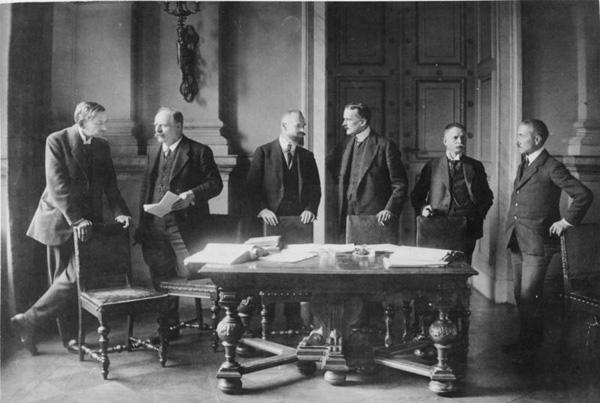
Treaty of Saint-Germain-en-Laye (part 1)
In 1919 On September 10, the Peace Treaty of Saint-Germain was signed with Austria. Like the other treaties of the Versailles system signed after the Second World War, the Treaty of Saint-Germain stipulated heavy obligations for Austria. In addition to significant territorial losses, Austria was obliged to pay reparations to the Allies. The preamble to the treaty proclaimed the collapse of Austria-Hungary. The former Austro-Hungarian Empire would be replaced by Austria, Hungary, Czechoslovakia, and the Kingdom of Serbo-Croatian-Slovenian (since 1929, Yugoslavia). A republican order would be established in Austria. Czechoslovakia and Yugoslavia were declared independent states by the Allies. Austria was also obliged to recognize the independence of the latter. Article 88 of the treaty prohibited the violation of Austria's independence, that is, it excluded the possibility of Anschluss. The Austrian armed forces were to be disbanded within 3 months. Austria would settle for 30,000 troops. Under Article 144, Austria was deprived of military aviation and the naval and Danube fleets were transferred to the Allies. Austria was also obliged to recognize all treaties of the Versailles system. The Treaty of Saint-Germain confirmed the fact of the collapse of the Austro-Hungarian Empire and the emergence of a number of new states on its territory. However, as a result of the agreement, a number of conflicts, including inter-ethnic ones, appeared, which subsequently aggravated the international situation many times.
Treaty of Ney
After protracted negotiations, a treaty was signed in Ney between Bulgaria, defeated in the First World War and the Entente. It was signed in 1919, on November 27 in the city of Niceur-Saint, a suburb of Paris. With this treaty, Bulgaria lost 11,000 square kilometers of territory, which went to the neighboring Serbo-Croatian-Slovenian Kingdom, Romania, and Greece. The four western regions of Bulgaria and part of Macedonia passed to the Kingdom of Serbo-Croatian-Slovenian. Western Thrace passed to the Entente (later under the control of Greece under the Treaty of Sevres in 1920, which deprived Bulgaria of access to the Aegean Sea). Dobruja was ceded to Romania. Bulgaria had to pay a war fine of 2250 billion gold francs over 37 years. The ground forces were to be reduced to 33,000, of which 20,000 were to be the Bulgarian army, 10,000 the police and 3,000 the border guards. Bulgaria was banned from having military aviation and heavy military equipment.
Treaty of Trianon
The Treaty of Trianon was signed between the states that won the First World War and Hungary, which was defeated in that war. It was signed in 1920. June 4 in the Grand Trianon Palace of Versailles and entered into force in 1921. on July 26. The United States, the British Empire, France, Italy, Japan, as well as Belgium, Greece, China, the Kingdom of Serbo-Croatian-Slovenian (since 1929 Yugoslavia), Cuba, Nicaragua, Panama, Poland, Portugal, Romania, Siam (Thailand) and Czechoslovakia. This treaty is considered part of the Versailles system of post-war settlement. Among the drafters of the peace treaty with Hungary was the Czech politician and diplomat Edward Benes, one of the authors of the creation of Czechoslovakia, who insisted that the approach to Hungary be tougher, because he believed that official Budapest was more to blame than Vienna for unleashing the First World War. In the negotiation process, France pursued to extract more territories from Hungary for the benefit of its neighbors, which would be a restraining factor for Hungary. As a result, an anti-Hungarian union known as the "Little Entente" was formed from Czechoslovakia, Romania, and Yugoslavia. The Treaty of Trianon was drawn up in accordance with the example of the Treaty of Saint-Germain. It consists of 364 articles, which are divided into 14 parts. The second part of the agreement refers to the borders of Hungary. As a result, Hungary suffered serious territorial losses:
• Transylvania and the eastern part of the Banat were joined to Romania,
• Croatia, Bacca and the western part of the Banat became part of the Serbo-Croatian-Slovenian kingdom.
• Slovakia and Transcarpathia joined Czechoslovakia,
• Burgeland passed to Austria.
But the official unification of Burgeland with Austria in 1921. caused a crisis on August 28. On the same day, Hungarian snipers stopped the actual occupation of the region by the Austrian police and border guards. Thanks to the intervention of Italian diplomats, the crisis was resolved in 1921. In autumn. A referendum was held on December 14-16, in which the Hungarian-dominated parts of Burgeland voted in favor of reunification with Hungary. As a result of the Treaty of Trianon, Hungary was deprived of 2/3 of its territory and population, as well as its access to the sea. In addition, the number of Hungarian troops should not exceed 30 thousand. Hungary was forbidden to have an air force, tanks and any other modern weapons (we will present the Treaty of Sèvres in a separate article).
Four Power Treaty
After a sharp diplomatic struggle in 1921 On December 13, the first treaty of the Washington Conference was signed between the United States, Great Britain, France, and Japan, known as the "Four Power Treaty." The treaty concerned the joint defense of the island territories belonging to the signatory states in the Pacific Ocean. This ten-year treaty marked a diplomatic victory for the United States, as its fourth article nullified the 1911 treaty. extended Anglo-Japanese treaty. The US President, US politicians Charles Evans Hughes, Henry Cabot Lodge Jr., Oscar Underwood, Elihu Ruth and a number of US citizens were appointed authorized representatives for the signing of the treaty.
The contract consisted of four clauses. The signatories undertook to respect the rights of others, particularly sovereignty, in their territories in the Pacific Ocean. If a diplomatically intractable and treaty-threatening conflict over the Pacific Ocean territories developed among the states that signed the treaty, then the states that signed the treaty should discuss and resolve the issue during a conference organized with the participation of representatives of the parties.
Add new comment